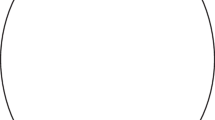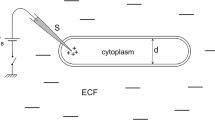Abstract
Deliberate evaluation of the quantum theory of nerve excitation is made by comparing it with Hill's theory in fitting the experimental data on threshold-frequency relation, optimum frequency (v0) for nerve excitation and strength-duration relation. Decrease of v0 and increase of all the time constants (Hill's λ andk, Wei'sT 2 and spike durationw) with decreasing temperature are interpreted on the basis of the dipole relaxation timeT 2 but inexplicable from Hill's theory or any other existing theory. The closeness ofk,T 2 andw values is explained. A variety of experimental results obtained by others is discussed. Finally, a comparison is made between the Hodgkin-Huxley equations and the quantum theory. Most of the facts (electrical and non-electrical) tend to support the thesis that nerve excitation is a macroscopic expression of quantum transitions of dipoles between energy states.
Similar content being viewed by others
Literature
Abott, B. C. and J. V. Howarth, 1973. “Heat studies in excitable tissues.”Physiol. Rev.,53, 120–158.
Adey, W. R. 1973. “Biophysical and metabolic bases of cooling effects on cat cortical membrane potentials.”UCLA Brain Res. Inst. Tech. Report.
Arndt, R. and L. D. Roper. 1972. “Quantitative comparison of dipole models for steadystate currents in excitable membranes.”Bull. Math. Biophys.,34, 305–324.
—, J. D. Bond and L. D. Roper. 1972. “A fit to nerve membrane rectification curves with a double-dipole layer membrane model.”Bull. Math. Biophys.,34, 151–172.
Binstock, L. and L. Goldman. 1969. “Current and voltage clamped studies inMyxicola giant axons.”J. Gen. Physiol.,54, 730–740.
Blair, H. A. 1932. “On the intensity-time relation for stimulation by electric currents, I, II.”J. Gen. Physiol.,15, 709–755.
—. 1934. “Conduction in nerve fibres.”Ibid.,18, 125–142.
—. 1936. “Kinetics of the excitatory process.”Cold Spr. Harb. Symp. quant. Biol.,4, 63–72.
Cohen, L. B., R. D. Keynes and B. Hille. 1968. “Light scattering and birefringence changes during nerve activity.”Nature,218, 438–441.
Cole, K. S. 1968. “Membranes, Ions and Impulses.” pp. 318–319. Berkeley: Univ. Calif. Press.
—, R. Guttman and F. Bezanilla. 1970. “Nerve membrane excitation without threshold.”Proc. Natn. Acad. Sci.,65, 884–891.
Frankenhaeuser, B. and A. L. Hodgkin, 1957. “The action of calcium on the electrical properties of squid axons.”J. Physiol., Lond.,137, 218–244.
Fraser, A. and A. H. Frey. 1968. “Electromagnetic emission at micro wavelengths from active nerves.”Biophys. J.,8, 731–734.
Gasser, H. S. 1931. “Nerve activity as modified by temperature.”Am. J. Physiol.,97, 254–270.
Hill, A. V. 1936a. Excitation and accommodation in nerve.Proc. R. Soc. Lond. 119, 305–355.
—. 1936b. “The strength-duration relation for electric excitation of medullated nerve.”Ibid.,119, 440–453.
—, B. Katz and D. Y. Solandt. 1936. “Nerve excitation by alternating current.” —Ibid.,,B121, 74–133.
Hodgkin, A. L. 1951. “The ionic basis of electrical activity in nerve and muscle.”Biol. Rev.,26, 339–409.
— and A. F. Huxley. 1952. “A quantitative description of membrane current and its application to conduction and excitation in nerve.”J. Physiol., Lond.,117, 500–544.
— and B. Katz. 1949. “The effect of temperature on the electrical activity of the giant axon of the squid.”Ibid.,109, 240–249.
Howarth, J. V., R. D. Keynes and J. M. Ritchie. 1968. “The origin of the initial heat associated with a single impulse in mammalian non-myelinated nerve fibres.”J. Physiol., Lond.,194, 745–793.
Inoue, I., Y. Kobatake and I. Tasaki. 1973. “Excitability, instability and phase transitions in squid axon membrane under internal perfusion with dilute salt solutions.”Biochim. Biophys. Acta. 307, 471–477.
Johnson, F. H., H. Eyring and M. J. Polissar, 1954.The Kinetic Basis of Molecular Biology, p. 656. New York, Wiley.
Katz, B. 1939.Electric Excitation of Nerve, Oxford. Univ Press.
Monnier, A. M. 1934.L'Excitation Electrique des Tissues. Paris: Hermann.
Rashevsky, N. 1933. “Outline of a physico-mathematical theory of excitation and inhibition.”Protoplasma,20, 42–56.
— 1960.Mathematical Biophysics Vol. 1, 3rd. rev. New York: Dover.
Segal, J. R. 1968. “Surface charge of giant axons of squid and lobster.”Biophys. J.,8, 470–489.
Sherebrin, M. H. 1972. “Changes in infrared spectrum of nerve during excitation.”Nature, New Biol.,235, 122–124.
Singer, J. R. 1959.Masers. New York: Wiley.
Solandt, D. Y. 1936. “The measurement of ‘accommodation’ in nerve.”Proc. R. Soc. Lond.,B119, 355–379.
Turner, R. S. 1955. “Relation between temperature and conduction in nerve fibres of different sizes.”Physiol. Zool.,28, 55–61.
Van Lamsweerde-Gallez, D. and A. Messen. 1974. “Surface dipoles, surface charges and negative steady-state resistance in biological membranes.”J. Biol. Phys.,2, 75–102.
Wei, L. Y. 1968. “Electrical dipole theory of chemical synaptic transmission.”Biophys. J.,8, 396–414.
—. 1969a. “Role of surface dipoles on axon membrane.”Science,163, 280–282.
—. 1969b. “Molecular mechanisms of nerve excitation and conduction.”Bull. Math. Biophys.,31, 39–58.
—. 1971a. “Quantum Theory of nerve excitation.”Ibid.,33, 187–194.
—. 1971b. “Possible origin of action potential and birefringence change in nerve axon.”Ibid.,33, 521–537.
—. 1972. “Dipole theory of heat production and absorption in nerve axon.”Biophys. J.,12, 1159–1170.
—. 1973. “Quantum theory of time-varying stimulation in nerve.”Bull. Math. Biol.,35, 359–374.
—. 1974. “Dipole mechanisms of electrical, optical and thermal energy tranductions in nerve membrane.”Ann. N.Y. Acad. Sci.,227, 285–293.
Wright, E. B. 1958. “The effect of low temperatures on single crustacean motor nerve fibres.”J. Cell. Comp. Physiol.,51, 29–65.
Author information
Authors and Affiliations
Rights and permissions
About this article
Cite this article
Hodson, C., Wei, L.Y. Comparative evaluation of quantum theory of nerve excitation. Bltn Mathcal Biology 38, 277–293 (1976). https://doi.org/10.1007/BF02459560
Received:
Revised:
Issue Date:
DOI: https://doi.org/10.1007/BF02459560




